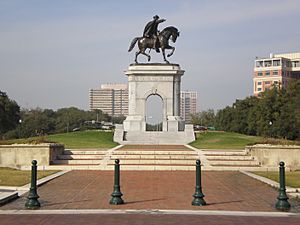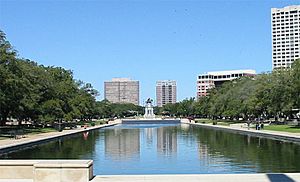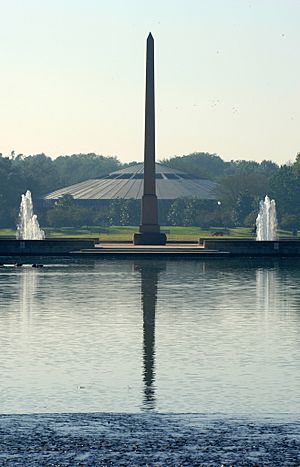Hermann Park facts for kids
Quick facts for kids Hermann Park |
|
|---|---|

Sam Houston Monument at the northern end of Hermann Park
|
|
| Type | Urban park |
| Location | Museum District, Houston, Texas, United States |
| Area | 445 acres (180 ha) |
| Created | 1914 |
| Designer | George Kessler |
| Operated by | Hermann Park Conservancy City of Houston |
| Visitors | 6 million |
| Open | 6 am – 11 pm daily |
| Public transit access | METRORail Red Line: Hermann Park / Rice University |
Hermann Park is a huge, 445-acre (180-hectare) park in Houston, Texas. It's located at the southern end of the Museum District, close to the Texas Medical Center and Rice University.
This amazing park is home to many fun places! You can visit the Houston Zoo, watch shows at the Miller Outdoor Theatre, explore the Houston Museum of Natural Science, or play a round at the Hermann Park Golf Course. This golf course was one of the first in the United States to allow people of all races to play together, starting in 1954. The park also has the beautiful Mary Gibbs and Jesse H. Jones Reflection Pool, lots of gardens, picnic spots, and McGovern Lake, an 8-acre (32,000 m2) lake where you can relax.
Hermann Park is one of Houston's oldest public parks. It was first imagined in the early 1900s as part of a big plan for the city. In 1914, a kind man named George H. Hermann, who owned much of the land, gave his estate to Houston to be used as a public park. By 1916, a famous landscape architect named George Kessler created a master plan for the park. This plan helped shape the park over many years.
Over time, the park changed. The Houston Zoo opened in 1922, and a large part of the park was used to create the Texas Medical Center in 1943. These changes affected the park's layout, but many parts of Kessler's original design are still there today. For a while, the park didn't get enough money or care, so it started to look a bit run-down. Because of this, a group of people formed the Hermann Park Conservancy in 1992. This group has raised over $120 million to fix up and improve many areas of the park.
Today, Hermann Park welcomes over six million visitors every year! The Houston Zoo alone had over 2.5 million visitors in 2016, making it one of the most popular zoos in the country. You can easily get to Hermann Park using public transportation, as the METRORail Red Line has a station right next to it.
Contents
Park History
Hermann Park has a rich history, with many important events shaping it into the wonderful place it is today.
- 1907 – The "Brownie" statue was placed in Sam Houston Park, which was Houston's first city park. This statue was a children's water fountain. It has been moved and even stolen a few times, but it now stands in front of Miller Outdoor Theatre in Hermann Park.
- 1914 – George E. Kessler designed the entrance to Hermann Park. He also created the overall plan for the park.
- 1924 – Hermann Park grew to 133.5 acres (54.0 ha) with the addition of the Golf Course. It was special because it had grass greens, which were not common at the time.
- 1936 – For Houston's 100th birthday, a log cabin was built in Hermann Park. It was a memorial to the brave pioneer men and women who helped settle Texas.
- 1957 – A special Southern Pacific steam engine, #982, was placed in Hermann Park. This also marked the start of the Mini-train service, which is still a popular ride today! The train was moved to Minute Maid Park in 2005.
The Hermann Park Conservancy
Hermann Park was given to the City of Houston by George Hermann in 1914. It is now one of Houston's most important public green spaces. Over the years, places like the Houston Zoo, Miller Outdoor Theatre, the Houston Museum of Natural Science, and the desegregated golf course have made the park even more special.
By the late 1980s, the park started to look a bit neglected. It didn't have enough money or care, even though many people visited it. To help fix this, a group of dedicated Houston citizens formed a non-profit organization called the Friends of Hermann Park (FHP) in 1992. Their goal was to make the park more beautiful and useful, bringing it back to its original glory.
Making the Park Better
In 1993, the Friends of Hermann Park asked experts to create a master plan for the park. This plan was like a "blueprint" for all the improvements and changes that would happen. Houston City Council approved the plan in 1997. In 2004, the Friends of Hermann Park changed their name to the Hermann Park Conservancy (HPC). This new name showed their lasting commitment to taking care of the park's nature and buildings.
A design competition was held to improve the main entrance and the reflecting pool, which is a key part of Hermann Park. The SWA Group, an international design firm, won the competition. One of the biggest changes was making the reflection pool narrower and more inviting. It became 80-foot-wide (24 m) and 740-foot-long (230 m). This new design created lovely walking paths and allowed for two rows of beautiful Live Oak trees. One row was planted in the 1920s to honor World War I veterans, and a second row was added as part of this project.
The "Heart of the Park" reflection pool even uses a special natural filtering system to keep the water clean. This system helps break down organic materials.
Ongoing Projects
The Hermann Park Conservancy continues to work with the City of Houston to get money and manage projects that improve the park. Here are some of the things they have worked on:
- Improving the Mary Gibbs and Jesse H. Jones Reflection Pool.
- Creating Molly Ann Smith and Sara H. and John H. Lindsey Plazas.
- Making McGovern Lake bigger and more beautiful, adding new islands and habitats for birds and wetlands.
- Building a new entrance and plaza for the Houston Zoo.
- Making North MacGregor Street better for easier access around the park and the Texas Medical Center.
- Adding more land and improvements to Bayou Parkland, an 80-acre (32 ha) area along Brays Bayou that is being restored for outdoor activities.
- Creating and running many stewardship programs, like Field Studies 101, to teach people about nature.
- Finishing the expansion and renovation of Miller Outdoor Theatre.
- Helping with the renovation of the Hermann Park Golf Course.
- Coordinating the expansion of the Hermann Park Miniature Train track.
- Planting over 2,400 new trees throughout the park.
- Installing new park benches, lights, and trash cans.
The Conservancy also created a plan for how to maintain and operate Hermann Park. They found that the park needed many more hours of care. To help with this, they hired a Manager of Volunteer Programs. In 2004, over 1,200 volunteers gave more than 14,000 hours of their time to help care for the park!
Park Attractions
Hermann Park is filled with many exciting places to visit and things to do!
- Arbor in the Pines
- Bayou Parkland
- Bloch Plaza Cancer Survivor's Plaza
- Brays Bayou
- Buddy Carruth Playground for All Children
- Chinese Pagoda
- Hermann Park Golf Course
- Hermann Park Jogging Trail
- Hermann Park Pedal Boats
- Hermann Park Railroad (a fun narrow-gauge train ride)
- Houston Garden Center
- Fragrance Garden
- Houston Museum of Natural Science
- Cockrell Butterfly Center
- Houston Zoo
- Japanese Garden
- Judson Robinson, Jr. Community Center
- Lake Overlook
- Mary Gibbs and Jesse H. Jones Reflection Pool
- Marvin Taylor Exercise Station
- McGovern Centennial Gardens
- McGovern Lake
- Bob's Fishing Pier
- Mecom Fountain
- Miller Outdoor Theatre
- Molly Ann Smith Plaza, with four interactive fountains
- Pioneer Memorial
- Pioneer Memorial Log House Museum
- Sam Houston Monument
- Urban Forest in Bayou Parkland
Images for kids
-
Sam Houston Monument with Warwick Towers in the background
See also
 In Spanish: Parque Hermann para niños
In Spanish: Parque Hermann para niños









